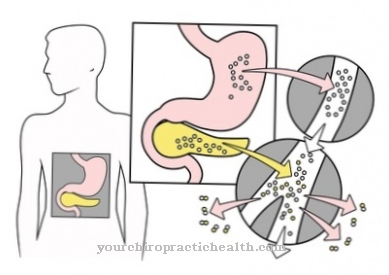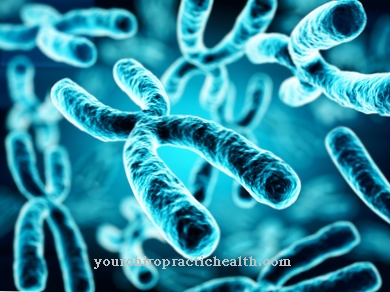The biochemical interactions in the organism represent the basis of life. Basically, build-up and breakdown processes take place in the body, which are associated with energy intake and energy release. Disturbances within the biochemical interactions are expressed in diseases.
What are biochemical interactions in the body?

The biochemical interactions in the body are explained by the science of biochemistry. It deals with the interaction of chemical and biological processes in the body. The metabolism closely interlinks biological and chemical processes. In medicine, the metabolic processes are examined in order to identify and treat disorders of these processes. The treatment of these diseases can then often be successful through the supply of certain active ingredients from the outside. This could be medication or a lack of active ingredients like vitamins.
However, for successful treatment it is necessary to know exactly the chemical processes. Biochemistry therefore deals, among other things, with the construction of biological structures, molecular building blocks and their interactions with one another. It examines how the substances are converted and which requirements, enzymes or hormones are necessary for the various processes.
At the same time, biochemistry also investigates how the exchange of information takes place inside and outside the organism and what paths there are for storing, retrieving and forwarding information.
Function & task
The biochemical interactions in the body are a general expression of life processes. Plants, for example, absorb inorganic substances such as carbon dioxide, water and mineral salts and convert them into organic compounds with the addition of solar energy. These organic compounds serve the plants to build up their biomass and to maintain the actual life processes.
Animal organisms, including humans, feed on organic matter that has already been built up. On the one hand, they build up the body's own connections and, on the other hand, use these substances to generate energy for physiological processes.
Basically, proteins, fats, carbohydrates and nucleic acids play an essential role for every organism. Proteins are polypeptides made up of around 20 different proteinogenic alpha amino acids. They fulfill many different functions in the organism. So they are involved in building muscles and all internal organs. They act as immunoglobulins to form antibodies.
All enzymes are made up of proteins. As enzymes, they catalyze the formation of important biochemical substances that are essential for the organism. Sometimes they also appear as hormones that develop certain biochemical effects. The different properties and functions of the proteins result in turn from the sequence of the amino acids present in the peptide chain. Replacing an amino acid can render the protein molecule ineffective or give it a completely different effect.
The so-called nucleic acids in DNA and RNA are responsible for the formation of proteins. The genetic code is stored in the DNA. This determines which proteins are produced and how they work. In addition to proteins and nucleic acids, every organism also needs carbohydrates and fats. While proteins are responsible for the structure and functions of the body, carbohydrates and fats provide the necessary energy for physical processes.
The basic building blocks of these biological agents are closely interlinked through the biochemical cycles. The citric acid cycle (citric acid cycle) plays a major role in the oxidative breakdown of organic compounds for energy generation. However, the basic building blocks of carbohydrates, fats and proteins can be converted into one another within this cycle.
One or more enzymes are necessary for almost every reaction step in the organism. In addition, the hormonal system represents a higher-level regulatory mechanism for coordinating physical functions with one another. The transmission of information within the cells, between the cells and especially between the nerve cells is closely linked to all other biochemical processes.
The processes are well coordinated and are mutually dependent. This good coordination of the processes has developed in the course of evolution. If this were not the case, the organisms could not survive or not develop in the first place.
Illnesses & ailments
The biochemical interactions in the organism are very complex and every deviation and disruption of the precisely coordinated processes can lead to serious health problems. The possibilities for pathological changes are manifold. There are both congenital and acquired forms of metabolic disorders.
Since enzymes are necessary for every reaction step in the conversion of the substances, a faulty enzyme can lead to considerable pathological processes. Defective enzymes are caused by gene mutations, in which often only one amino acid is exchanged.
One example is phenylketonuria. The enzyme that catalyzes the breakdown of the amino acid phenylalanine is restricted in its effect by a gene mutation. The buildup of phenylalanine in the brain causes severe mental damage if left untreated. A diet low in phenylalanine can save adolescents from this condition.
Many other substances are essential for the body. That means they have to be taken in with the diet. This applies to vitamins, minerals and some amino acids. If they are missing in the diet, deficiency symptoms occur, which are often associated with serious diseases, such as scurvy in the case of vitamin C deficiency.
Another typical example of acquired metabolic disorders is the metabolic syndrome with obesity, diabetes mellitus, lipid metabolism disorders and arteriosclerosis. The reason for this is an incorrect diet with too many carbohydrates and fats for years, which cannot be processed in the human biological blueprint.



























